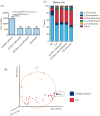Fungal Dysbiosis in Mucosa-associated Microbiota of Crohn's Disease Patients
- PMID: 26574491
- PMCID: PMC4957473
- DOI: 10.1093/ecco-jcc/jjv209
Fungal Dysbiosis in Mucosa-associated Microbiota of Crohn's Disease Patients
Abstract
Background and aims: Gut microbiota is involved in many physiological functions and its imbalance is associated with several diseases, particularly with inflammatory bowel diseases. Mucosa-associated microbiota could have a key role in induction of host immunity and in inflammatory process. Although the role of fungi has been suggested in inflammatory disease pathogenesis, the fungal microbiota has not yet been deeply explored. Here we analysed the bacterial and fungal composition of the mucosa-associated microbiota of Crohn's disease patients and healthy subjects.
Methods: Our prospective, observational study evaluated bacterial and fungal composition of mucosa-associated microbiota of 23 Crohn's disease patients [16 in flare, 7 in remission] and 10 healthy subjects, using 16S [MiSeq] and ITS2 [pyrosequencing] sequencing, respectively. Global fungal load was assessed by real time quantitative polymerase chain reaction.
Results: Bacterial microbiota in Crohn's disease patients was characterised by a restriction in biodiversity. with an increase of Proteobacteria and Fusobacteria. Global fungus load was significantly increased in Crohn's disease flare compared with healthy subjects [p < 0.05]. In both groups, the colonic mucosa-associated fungal microbiota was dominated by Basidiomycota and Ascomycota phyla. Cystofilobasidiaceae family and Candida glabrata species were overrepresented in Crohn's disease. Saccharomyces cerevisiae and Filobasidium uniguttulatum species were associated with non-inflamed mucosa, whereas Xylariales order was associated with inflamed mucosa.
Conclusions: Our study confirms the alteration of the bacterial microbiota and is the first demonstration of the existence of an altered fungal microbiota in Crohn's disease patients, suggesting that fungi may play a role in pathogenesis.
Keywords: Inflammatory bowel disease; fungal microbiota; mucosa-associated microbiota.
Copyright © 2015 European Crohn’s and Colitis Organisation (ECCO). Published by Oxford University Press. All rights reserved. For permissions, please email: journals.permissions@oup.com.
Figures






References
-
- Savage DC. Microbial ecology of the gastrointestinal tract. Annu Rev Microbiol 1977;31:107–33. - PubMed
-
- Reiners JJ, Clift R, Mathieu P. Suppression of cell cycle progression by flavonoids: dependence on the aryl hydrocarbon receptor. Carcinogenesis 1999;20:1561–6. - PubMed
-
- Xavier RJ, Podolsky DK. Unravelling the pathogenesis of inflammatory bowel disease. Nature 2007;448:427–34. - PubMed
Publication types
MeSH terms
Substances
LinkOut - more resources
Full Text Sources
Other Literature Sources
Medical

